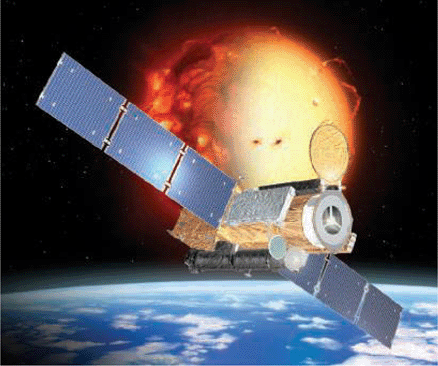|
It's the Astronomy Online non-Blog, or un-Blog.
Everyone has a blog now and since I am no follower of trends, I decided to merge the blog with the website. And I don't want to neglect the website in favor of posting on the blog.
These are the pages that were on the blog of old:
- Home
- Archive (Index of Pages)
- Me
- Current Trends
- Links
- Soho Live
Links:
Google Maps - Mars
Google Maps - Moon
HiRISE
HiRISE - MRO Imaging
Mac Singularity
Meade4M
Slackerpedia Galactica
Software for the Mac
Starry Night Online
Venus Maps
More Favorites:


































Thank you for visiting!
|
|
 |
|
New Solar Mission Brightens Research:
In the path of Yohkoh and SOHO, the Solar-B probe will fill in the gaps of solar research. Launched today (September 23, 2006) from Japan's Uchinoura Space Center, the $210 million dollar probe will carry three telescopes: a 0.5 meter telescope, an improved X-ray telescope and an extreme ultraviolet imaging spectrometer.

The Solar-B probe is a partnership between the JAXA, NASA and the U.K.'s Particle Physics and Astronomy Research Council. The goal of the mission is to determine the types of magnetic field lines on the surface of the Sun as well as determine the movements of these magnetic field lines. By studying these lines, it is hoped that a model can be used for predicting solar flares and Coronal Mass Ejections (CME's) - these are extremely violent events that send a tremendous amounts of energy towards Earth. While the Earth's magnetosphere and atmosphere protect us from these events, communication disruptions can occur as well a risk to our astronauts on their space-walks (and future manned missions to the Moon and Mars).
The 0.5 meter telescope will be the largest instrument used for observing the Sun in space and will allow resolution capability of only 150 km across. Attached to this telescope will be a vector magnetograph that will determine the orientation of magnetic field lines. The improved X-ray telescope will provide detailed views of solar flares and will be able to measure temperatures well above 10 million Kelvin. The extreme ultraviolet imaging spectrometer will gather data on the solar plasma from the corona to the underlying magnetic fields.
The probe has a 3 year life span and will operate of 8 consecutive months per year. The Yohkoh probe operated from 1991 to 2001; the SOHO probe launched in 1995 and is still active.
Image Credit: JAXA/ISAS
References:
Science 15 September 2006: Vol. 313. no. 5793, p. 1553 DOI: 10.1126/science.313.5793.1553a
Solar-B Website
Japan Aerospace Exploration Agency (JAXA)
SOHO Website
Yohkoh Website
Next Post | Previous Post | Back to Top
|
|

